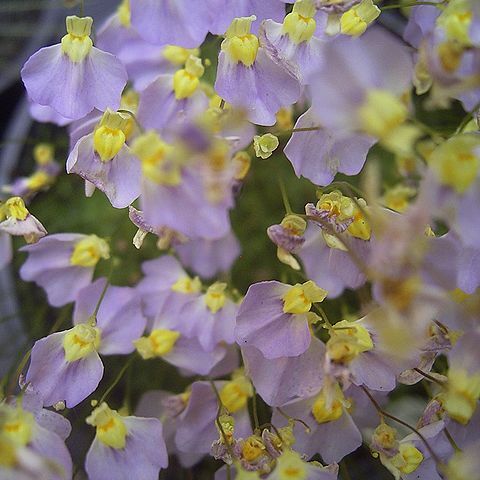Small annual, terrestrial. Rhizoids few, capillary, simple, a few mm long, up to 0.1 mm thick. Stolons few, capillary, branched, a few cm long, up to 0.2 mm thick. Leaves few from the peduncle base and others scattered on the stolons, petiolate, the lamina very narrowly obovate to linear, with apex rounded, up to 1 mm wide, 1-nerved; total length up to 1.5 cm. Traps numerous on the stolons and leaf petioles, ovoid, stalked, 1-1.5 mm long, the mouth terminal with a rounded dorsal appendage, the appendage and the receding ventral lip of the mouth fringed with radiating rows of stipitate glands. Inflorescence erect, simple, solitary, 1.5-2.5 cm long. Peduncle terete, 0.2-0.5 mm thick, glabrous throughout or papillose below. Scales few or absent, similar to the bracts but smaller. Bracts basifixed, ovate, with apex acute, up to 1 mm long. Bracteoles linear, with apex acute or obtuse, about as long as the bract. Flowers 1-6, distant; pedicels capillary, terete, 1-3 mm long. Calyx lobes subequal, broadly ovate with apex of upper lobe rounded or shortly tridentate, and of lower lobe rounded or shortly bi-or tridentate, 1-2.5 mm long, membranous, usually plicate along the few simple nerves. Corolla (2-)5-10(-16) mm long, shades of lilac or violet with a yellow patch at the base of the lower lip, sometimes white or rarely wholly or mostly yellow; upper lip constricted below the middle, the inferior part broadly ovate, the superior part ovate with the apex ± deeply emarginate; lower lip limb approximately circular or transversely elliptic, with a prominent, rounded swelling at the base, the apex rounded, ± conspicuously 3-5 crenate; palate margin shortly pubescent; spur narrowly cylindrical or subulate with apex obtuse to acute, straight or slightly, curved, or abnormally saccate, usually about as long as the lower lip but sometimes much shorter or considerably longer. Filaments curved, 0.3-0.7 mm long, the anther thecae subdistinct. Ovary globose; style short; stigma lower lip semicircular, the upper lip very much smaller, deltoid. Capsule globose, 1.5-2 mm long, the wall firm in texture, dehiscing by a ventral, longitudinal, marginally thickened slit. Seeds transversely ellipsoid, c. 0.25 mm long. Mostly collected in flower between August and January in S. Africa (February and April in Angola).
More
Annual, carnivorous herb. Leaves: blade very narrowly obovate to linear, 1-veined. Traps ovoid, mouth terminal. Flowers in a simple raceme 15-25 mm long; violet to white, rarely yellow, with yellow palate. Calyx lobes Sub-Equal, broadly ovate, usually pleated along the few veins. Corolla: upper lip with 2 ovate parts in tandem; lower lip much larger, ± circular, 3-or 5-crenate; spur ± as long as lower lip. Flowering time Aug.-Jan., mainly Sept.
Annual to 12 cm. Leaves linear. Flowers 1-few, bracteate, white to lilac (rarely yellowish) with smooth, yellow palate obscuring mouth, lower lip 3-5-crenate, upper lip much smaller, emarginate, purple-streaked, spur ± as long as lower lip. Fruits erect.


